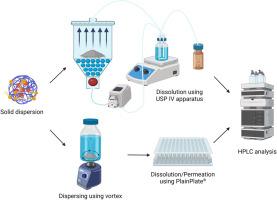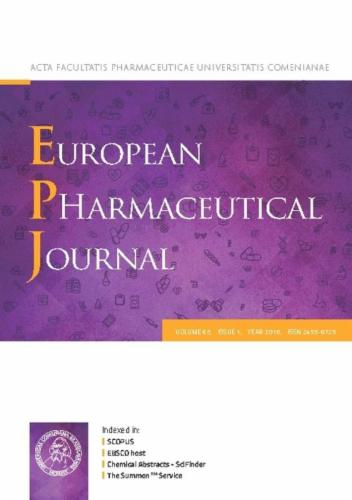含有不同等级氢化磷脂的非诺贝特熔融挤出制剂在体外生物制药方面表现良好
IF 4.3
3区 医学
Q1 PHARMACOLOGY & PHARMACY
引用次数: 0
摘要
本研究证明,三种市售氢化磷脂(HPL)的磷脂酰胆碱含量不同,可用作热熔挤出二元(HPL 为唯一辅料)或三元(与共聚维酮混合)非诺贝特(FEN)固体分散体的成分,质量分数在 0.5%至 20%(三元)或 80%(二元)之间。X 射线粉末衍射表明,通过热熔挤压,所有三元共混物的结晶非诺贝特均完全转化为无定形状态。相比之下,二元共混物(基于 HPL 和共聚维酮)都含有少量残余结晶。无论如何,所有固体分散体在溶解研究过程中都会诱导 FEN 的过饱和状态,其中三元 ASD 与二元混合物相比,FEN 的释放更强、更完全,与市场上的微粉和纳米研磨制剂相比,释放更明显。在累积渗透量方面,当使用 FeSSIF 作为供体介质进行溶解/渗透联合试验时,不同配方之间存在微小差异;在使用 FaSSIF 作为供体介质时,含有磷脂酰胆碱组分最高等级的二元 HPL-ASD 在渗透方面表现最佳,甚至明显优于市场上销售的纳米晶体配方。此外,在对三元固体分散体的 FEN 溶解和渗透性进行分析时,不同等级的 HPL 之间也没有明显差异。总之,通过热熔挤压法生产的含氢磷脂混合物在体外生物制药方面表现良好。对于 FEN 等水溶性和亲油性较差的药物化合物来说,它们是一种可行的制剂选择。本文章由计算机程序翻译,如有差异,请以英文原文为准。

Melt-extruded formulations of fenofibrate with various grades of hydrogenated phospholipid exhibit promising in-vitro biopharmaceutical behavior
In the current study, it was demonstrated that three commercially available grades of hydrogenated phospholipids (HPL) differing in their content of phosphatidylcholine may be used as components for hot melt-extruded binary (HPL as sole excipient) or ternary (in combination with copovidone) solid dispersions of fenofibrate (FEN) at mass fractions between 0.5 and 20% (ternary) or 80% (binary). X-ray powder diffraction indicated complete conversion of crystalline fenofibrate into the amorphous state by hot melt extrusion for all ternary blends. In contrast, both the binary blends (HPL- and copovidone-based) contained minor remaining crystallites. Irrespectively, all solid dispersions induced during dissolution studies a supersaturated state of FEN, where the ternary ASDs showed enhanced and more complete release of FEN as compared to the binary blends and, even more pronounced, in comparison to the marketed micronized and nano-milled formulations. In terms of the cumulated amount permeated, there were marginal differences between the various formulations when combined dissolution/permeation was done using FeSSIF as donor medium; with FaSSIF as donor medium, the binary HPL-ASD containing the grade with the highest phosphatidylcholine fraction performed best in terms of permeation, even significantly better than the marketed nano-crystal formulation. Otherwise, no significant differences were seen between the various grades of HPL when FEN dissolution and permeation were analyzed for ternary solid dispersions. In conclusion, the in-vitro biopharmaceutical behaviour of hydrogenated phospholipid-containing blends manufactured by hot melt extrusion appears promising. They can be a viable formulation option for poorly water-soluble and lipophilic drug compounds like FEN.
求助全文
通过发布文献求助,成功后即可免费获取论文全文。
去求助
来源期刊
CiteScore
9.60
自引率
2.20%
发文量
248
审稿时长
50 days
期刊介绍:
The journal publishes research articles, review articles and scientific commentaries on all aspects of the pharmaceutical sciences with emphasis on conceptual novelty and scientific quality. The Editors welcome articles in this multidisciplinary field, with a focus on topics relevant for drug discovery and development.
More specifically, the Journal publishes reports on medicinal chemistry, pharmacology, drug absorption and metabolism, pharmacokinetics and pharmacodynamics, pharmaceutical and biomedical analysis, drug delivery (including gene delivery), drug targeting, pharmaceutical technology, pharmaceutical biotechnology and clinical drug evaluation. The journal will typically not give priority to manuscripts focusing primarily on organic synthesis, natural products, adaptation of analytical approaches, or discussions pertaining to drug policy making.
Scientific commentaries and review articles are generally by invitation only or by consent of the Editors. Proceedings of scientific meetings may be published as special issues or supplements to the Journal.

 求助内容:
求助内容: 应助结果提醒方式:
应助结果提醒方式:


